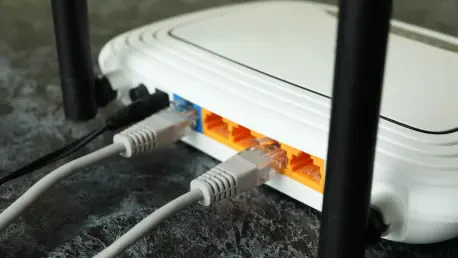Could your wireless router be an open door for cyber threats? As personal and professional networks expand, securing digital infrastructures becomes more critical than ever. Recent reports reveal a staggering increase in vulnerabilities, with an alarming statistic indicating that over 60% of home and office networks are susceptible to cyber-attacks due to unsecured routers.
The Unseen Threat: Why Router Vulnerabilities Matter
Router security often slips under the radar despite its pivotal role in today’s hyper-connected world. Vulnerabilities like those discovered in certain TP-Link routers underscore a growing trend in cyber incidents. Cyber-attacks have become more frequent and sophisticated, substantially impacting businesses by compromising sensitive data and disrupting operations. Personal data breaches remain a significant concern, given the ease with which attackers can exploit networks through outdated or flawed systems.
Unpacking TP-Link’s Security Flaws
The recent security flaw, designated CVE-2023-33538, presents a severe threat to various TP-Link router models. This vulnerability, with a high CVSS score of 8.8, enables attackers to inject commands through the ssid1 parameter via a crafted HTTP GET request. Specifically, the affected models are the TP-Link TL-WR940N V2/V4, TL-WR841N V8/V10, and TL-WR740N V1/V2. These models, lacking updates since their discontinuation in 2017, can be targeted for network breaches similar to previous high-profile exploits. The consequences can be severe, as unauthorized access potentially leads to data theft, system disruptions, and broader network compromises.
Expert Insights and User Experiences
Experts from cybersecurity agencies, such as the Cybersecurity & Infrastructure Security Agency (CISA), emphasize the risks associated with aging hardware. Analysts warn that outdated routers present significant risks, pointing to incidents where unpatched devices became entry points for large-scale cyber threats. A user recently shared an experience where a similar vulnerability led to unauthorized access, resulting in a forced network shutdown and a costly security overhaul. Such real-life incidents illustrate the necessity of prioritizing router security in today’s digital age.
Taking Control: Steps to Secure Your Network
Addressing the aforementioned vulnerability in TP-Link routers involves several critical actions. Users should contact TP-Link for patched firmware or, if recommended, consider upgrading to devices that receive regular updates automatically. Additionally, regular monitoring and restricting device exposure are crucial strategies in maintaining network integrity. Long-term solutions may include investing in advanced security-focused routers to stay ahead of potential threats, ensuring the network is fortified against both existing and emerging vulnerabilities.
Looking Forward: Navigating Cybersecurity Challenges
In light of these vulnerabilities, the need for vigilance in cybersecurity cannot be overstated. Users have taken steps to upgrade their networks and invested in more secure hardware, significantly reducing risks. As network infrastructures evolve, past experiences highlight the importance of timely updates and proactive measures. Staying informed and engaged with tech support proved vital in safeguarding personal and business environments, creating a fortified digital landscape against future threats.









